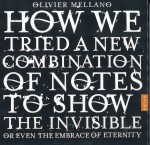 One of the most intriguing releases to come my way in a good long time is the 3-CD + DVD set How We Tried a New Combination of Notes to Show the Invisible or Even the Embrace of Eternity,featuring the music of 40-something French composer and guitarist Olivier Mellano (naïve MO 782182).
One of the most intriguing releases to come my way in a good long time is the 3-CD + DVD set How We Tried a New Combination of Notes to Show the Invisible or Even the Embrace of Eternity,featuring the music of 40-something French composer and guitarist Olivier Mellano (naïve MO 782182).
The first disc is devoted to the eponymous extended symphonic work commissioned by the Orchestre symphonique de Bretagne which performs with soprano Valérie Gabail under the direction of Québécois conductor Jean-Michaël Lavoie. Both the music and the text (in six languages plus a recitation of the formulas for the first 17 numbers of the Fibonacci series) are by Mellano. The gorgeous long melodic soprano line soars over orchestral textures that range from placid to tumultuous throughout the five movements, with a passing similarity to Górecki’s iconic Symphony of Sorrowful Songs. As moving and dramatic as this work is, what makes it especially interesting are the variations that follow on the other two CDs. Mellano has taken the basic material of the soprano/orchestral composition and reworked it for male voice (half sung and half spoken by Simon Huw Jones), 17 electric guitars (overdubbed by the composer) and drums (Nicolas Courret). In this instance the text is rendered entirely in English and comes to the forefront. This is even more the case in the third version in which the lyrics are “co-written and re-imagined” by Hip-Hop veteran MC Dälek (Will Brooks). The various transformations are stunning and taken to yet another level with a silent narrative interpretation by French filmmaker Alanté Kavaïté using Cocteau-like images over a soundtrack of the original orchestral version.
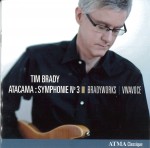 Mellano’s was not the only intriguing symphonic work involving voice and electric guitar to come my way this month. Tim Brady – Atacama: Symphony No.3 featuring Bradyworks and Vivavoce (ATMA ACD2 2676) is a settingof poems from the collection Symphony by Chilean activist Elias Letelier who was given sanctuary in Canada in 1981 after being imprisoned and tortured by the Pinochet regime. Brady says “The text speaks of the political terror of the Pinochet era in Chile, one of the country’s darkest moments, but it uses striking metaphors of hope and love in the midst of the nightmare of torture and disappearances. This mixture of tenderness and cruelty, of light and dark, gave me a kind of strong emotional and dramatic contrast that I look for in a text.” His effective settings range from mostly a cappella, close harmony singing by the virtuosic Montreal choir to extended, often minimalistic rhythmical instrumental passages by his unique ensemble of keyboards, percussion, flute(s), clarinet(s), saxophone(s), violin, viola, double bass and his own electric guitar. Perhaps most effective are the movements that skilfully combine the two as Brady continues to redefine the designation “symphony.”
Mellano’s was not the only intriguing symphonic work involving voice and electric guitar to come my way this month. Tim Brady – Atacama: Symphony No.3 featuring Bradyworks and Vivavoce (ATMA ACD2 2676) is a settingof poems from the collection Symphony by Chilean activist Elias Letelier who was given sanctuary in Canada in 1981 after being imprisoned and tortured by the Pinochet regime. Brady says “The text speaks of the political terror of the Pinochet era in Chile, one of the country’s darkest moments, but it uses striking metaphors of hope and love in the midst of the nightmare of torture and disappearances. This mixture of tenderness and cruelty, of light and dark, gave me a kind of strong emotional and dramatic contrast that I look for in a text.” His effective settings range from mostly a cappella, close harmony singing by the virtuosic Montreal choir to extended, often minimalistic rhythmical instrumental passages by his unique ensemble of keyboards, percussion, flute(s), clarinet(s), saxophone(s), violin, viola, double bass and his own electric guitar. Perhaps most effective are the movements that skilfully combine the two as Brady continues to redefine the designation “symphony.”
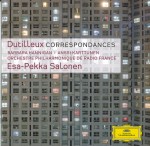 As we celebrate a myriad of centennials this season it would behoove us to keep in mind some of the senior living composers who continue to create. Henri Dutilleux is a case in point at the age of 97. The latest release of his music, Correspondances (DG 479 1180), includes the world premiere recording of the title piece featuring Canadian soprano Barbara Hannigan. Although there are no performer bios included in the booklet, according to the blurb on the back of the CD Hannigan is “today’s foremost interpreter of contemporary vocal music.” She has performed the work with both the Toronto and the Montreal symphonies. Although originally written for Dawn Upshaw, Dutilleux was so impressed with Hannigan’s performance that he rewrote the ending especially for her. Also included are the cello concerto Tout un Monde Lointain with Anssi Karttunen and The Shadows of Time, a work based on The Diary of Anne Frank. The Orchestre Philharmonique de Radio France andconductor Esa-Pekka Salonen recorded this disc in the presence of the composer. Dutilleux is no stranger to Toronto audiences and the TSO’s 1998 recording of Symphony No.2, Metaboles and Timbres, Espace, Mouvement under Jukka-Pekka Saraste is still available (Finlandia 3984 2525324-2). Both discs are highly recommended.
As we celebrate a myriad of centennials this season it would behoove us to keep in mind some of the senior living composers who continue to create. Henri Dutilleux is a case in point at the age of 97. The latest release of his music, Correspondances (DG 479 1180), includes the world premiere recording of the title piece featuring Canadian soprano Barbara Hannigan. Although there are no performer bios included in the booklet, according to the blurb on the back of the CD Hannigan is “today’s foremost interpreter of contemporary vocal music.” She has performed the work with both the Toronto and the Montreal symphonies. Although originally written for Dawn Upshaw, Dutilleux was so impressed with Hannigan’s performance that he rewrote the ending especially for her. Also included are the cello concerto Tout un Monde Lointain with Anssi Karttunen and The Shadows of Time, a work based on The Diary of Anne Frank. The Orchestre Philharmonique de Radio France andconductor Esa-Pekka Salonen recorded this disc in the presence of the composer. Dutilleux is no stranger to Toronto audiences and the TSO’s 1998 recording of Symphony No.2, Metaboles and Timbres, Espace, Mouvement under Jukka-Pekka Saraste is still available (Finlandia 3984 2525324-2). Both discs are highly recommended.
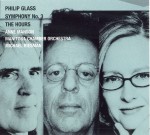 If the DG disc can be faulted for having no performer bios, the next disc goes to the opposite extreme. The latest release on Orange Mountain Music (OMM 0086), a label devoted to the music of Philip Glass, features the Manitoba Chamber Orchestra under Anne Manson’s direction. In this instance the booklet includes two pages about the conductor, two pages about the guest piano soloist (Glass’s collaborator Michael Riesman), a page about the orchestra and full credits for the recording done at Glenn Gould Studio, but not one word about the composer or the music. I understand that a label which features Glass’ music exclusively might not need to include his biography on every release, but I was very surprised that there were no program notes about the pieces, Symphony No.3 and The Hours. The symphony, for string orchestra, surprised me as not being typical of the composer’s minimalist style, at least not until the third movement. The first two movements are reminiscent of English string symphonies of the early 20th century, although this wouldn’t really be mistaken for one, with only the final two more recognizable as Glass. The Hours is a suite arranged by Riesman from Glass’s original music for the 2002 film of the same name. It is lush and warm and beautifully balanced, exactly what we have come to expect from the cinematic Glass with his repetitive wash of diatonic unison melodies. Listening to the suite enticed me to revisit the marvellous film with a stellar cast including Nicole Kidman as Virginia Woolf. I now look forward to re-reading Michael Cunningham’s book on which it was based. By the way, the DVD of the movie includes an interesting bonus track with Glass discussing the music.
If the DG disc can be faulted for having no performer bios, the next disc goes to the opposite extreme. The latest release on Orange Mountain Music (OMM 0086), a label devoted to the music of Philip Glass, features the Manitoba Chamber Orchestra under Anne Manson’s direction. In this instance the booklet includes two pages about the conductor, two pages about the guest piano soloist (Glass’s collaborator Michael Riesman), a page about the orchestra and full credits for the recording done at Glenn Gould Studio, but not one word about the composer or the music. I understand that a label which features Glass’ music exclusively might not need to include his biography on every release, but I was very surprised that there were no program notes about the pieces, Symphony No.3 and The Hours. The symphony, for string orchestra, surprised me as not being typical of the composer’s minimalist style, at least not until the third movement. The first two movements are reminiscent of English string symphonies of the early 20th century, although this wouldn’t really be mistaken for one, with only the final two more recognizable as Glass. The Hours is a suite arranged by Riesman from Glass’s original music for the 2002 film of the same name. It is lush and warm and beautifully balanced, exactly what we have come to expect from the cinematic Glass with his repetitive wash of diatonic unison melodies. Listening to the suite enticed me to revisit the marvellous film with a stellar cast including Nicole Kidman as Virginia Woolf. I now look forward to re-reading Michael Cunningham’s book on which it was based. By the way, the DVD of the movie includes an interesting bonus track with Glass discussing the music.
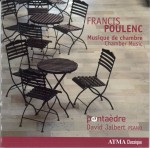 Brief notes: It’s hard to keep up with all the excellent new releases by Montreal’s ATMA label. I was very pleased to find that one of their latest features a work that I fell in love with in my formative years and have not had occasion to revisit recently, the Sextet for piano and wind quintetby Francis Poulenc. It gets a stirring performance by David Jalbert and the woodwind quintet Pentaèdre on Francis Poulenc – Chamber Music (ACD2 2646). The disc also includes fine renditions of the sonatas for flute and piano and clarinet and piano, the Elégie for horn and piano and the Trio for piano, oboe and bassoon. A very welcome addition to the catalogue.
Brief notes: It’s hard to keep up with all the excellent new releases by Montreal’s ATMA label. I was very pleased to find that one of their latest features a work that I fell in love with in my formative years and have not had occasion to revisit recently, the Sextet for piano and wind quintetby Francis Poulenc. It gets a stirring performance by David Jalbert and the woodwind quintet Pentaèdre on Francis Poulenc – Chamber Music (ACD2 2646). The disc also includes fine renditions of the sonatas for flute and piano and clarinet and piano, the Elégie for horn and piano and the Trio for piano, oboe and bassoon. A very welcome addition to the catalogue.
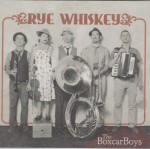 Rye Whiskey is the latest offering from the eclectic local quasi old-time music quintet The Boxcar Boys (www.theboxcarboys.ca). Theunusual instrumentation of the group — clarinet, accordion, violin, trombone and sousaphone, supplemented by mandolin on some tracks — works surprisingly well in a wide range of music that spans original compositions in the form of waltzes, stomps and tangos to the standards Freight Train and You Are My Sunshine, and traditional tunes like the title track. The music is mostly instrumental and happily so. The occasional vocals are tentative at best, and while I think this may be part of the point — reminiscent of scratchy, distant sounding early 20th century folk recordings — in contrast to the high sound quality of the instrumentals they seem incongruent. Overall though, this disc is a wonderful swinging romp through a variety of hills and dales, swamps and deltas.
Rye Whiskey is the latest offering from the eclectic local quasi old-time music quintet The Boxcar Boys (www.theboxcarboys.ca). Theunusual instrumentation of the group — clarinet, accordion, violin, trombone and sousaphone, supplemented by mandolin on some tracks — works surprisingly well in a wide range of music that spans original compositions in the form of waltzes, stomps and tangos to the standards Freight Train and You Are My Sunshine, and traditional tunes like the title track. The music is mostly instrumental and happily so. The occasional vocals are tentative at best, and while I think this may be part of the point — reminiscent of scratchy, distant sounding early 20th century folk recordings — in contrast to the high sound quality of the instrumentals they seem incongruent. Overall though, this disc is a wonderful swinging romp through a variety of hills and dales, swamps and deltas.
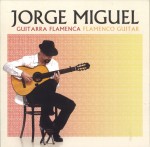 Toronto-based flamenco guitarist Jorge Miguel (www.jorgemiguel.com) has undertaken a monthly residency at the Lula Lounge (next instalment April 17) in support of his latest release Guitarra Flamenca (Andaluz Music AM1012). The playing is crisp and nuanced with lively, if minimal, support from percussionists Luis Orbegoso and Daniel Stone — often with just complex hand clapping — and bassist Justin Gray. Highlights include the opener Tortilla de Buleria, the rousing Rumba Tangos with vocals by the percussionists and the somewhat introspective Romance del Amargo, the only non-original composition on the disc. Written by Federico Garcia Lorca and Ricardo Pachon, it works very well in Miguel’s arrangement. In all this is a very satisfying release, one that makes it hard to keep your feet still.
Toronto-based flamenco guitarist Jorge Miguel (www.jorgemiguel.com) has undertaken a monthly residency at the Lula Lounge (next instalment April 17) in support of his latest release Guitarra Flamenca (Andaluz Music AM1012). The playing is crisp and nuanced with lively, if minimal, support from percussionists Luis Orbegoso and Daniel Stone — often with just complex hand clapping — and bassist Justin Gray. Highlights include the opener Tortilla de Buleria, the rousing Rumba Tangos with vocals by the percussionists and the somewhat introspective Romance del Amargo, the only non-original composition on the disc. Written by Federico Garcia Lorca and Ricardo Pachon, it works very well in Miguel’s arrangement. In all this is a very satisfying release, one that makes it hard to keep your feet still.
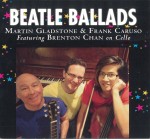 The final disc I will mention is one that would not normally find its way into our pages due to its mainstream pop sensibility, but Beatle Ballads (www.martinandfrank.com) is quite surprising in its accomplishment. Singer/guitarist Martin Gladstone, well known on the Toronto scene for a number of decades now, and his younger colleagues Frank Caruso (piano and direction) and Brenton Chan (cello), have managed to capture the essence of 17 of the most poignant Beatles songs in their solo voice and instrumental trio arrangements. Purists will no doubt prefer to stick with the originals, but as a tribute album this features a great selection of well-loved tunes, lovingly performed. Highlights will no doubt vary with your own particular favourite Beatle songs, but even this jaded old critic (not known to have a fondness for the Fab Four) can’t resist such gems as Here Comes the Sun, Michelle, Julia and While My Guitar Gently Weeps.
The final disc I will mention is one that would not normally find its way into our pages due to its mainstream pop sensibility, but Beatle Ballads (www.martinandfrank.com) is quite surprising in its accomplishment. Singer/guitarist Martin Gladstone, well known on the Toronto scene for a number of decades now, and his younger colleagues Frank Caruso (piano and direction) and Brenton Chan (cello), have managed to capture the essence of 17 of the most poignant Beatles songs in their solo voice and instrumental trio arrangements. Purists will no doubt prefer to stick with the originals, but as a tribute album this features a great selection of well-loved tunes, lovingly performed. Highlights will no doubt vary with your own particular favourite Beatle songs, but even this jaded old critic (not known to have a fondness for the Fab Four) can’t resist such gems as Here Comes the Sun, Michelle, Julia and While My Guitar Gently Weeps.
We welcome your feedback and invite submissions. CDs and comments should be sent to: The WholeNote, 503–720 Bathurst St., Toronto ON, M5S 2R4. We also encourage you to visit our website, thewholenote.com, where you can find added features including direct links to performers, composers and record labels and additional, expanded and archival reviews.
—David Olds, DISCoveries Editor
discoveries@thewholenote.com



